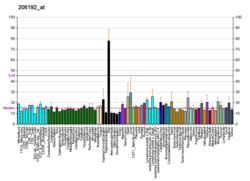
Keratin 18 is a type I cytokeratin. It is, together with its filament partner keratin 8, perhaps the most commonly found products of the intermediate filament gene family. They are expressed in single layer epithelial tissues of the body. Mutations in this gene have been linked to cryptogenic cirrhosis. Two transcript variants encoding the same protein have been found for this gene.

Keratin 16 is a protein that in humans is encoded by the KRT16 gene.

Aquaporin 3 (AQP-3) is the protein product of the human AQP3 gene. It is found in the basolateral cell membrane of principal collecting duct cells and provides a pathway for water to exit these cells. Aquaporin-3 is also permeable to glycerol, ammonia, urea, and hydrogen peroxide. It is expressed in various tissues including the skin, respiratory tract, and kidneys as well as various types of cancers. In the kidney, aquaproin-3 is unresponsive to the antidiuretic hormone vasopressin, unlike aquaporin-2. This protein is also a determinant for the GIL blood group system.

Collagen XVII, previously called BP180, is a transmembrane protein which plays a critical role in maintaining the linkage between the intracellular and the extracellular structural elements involved in epidermal adhesion, identified by Diaz and colleagues in 1990.
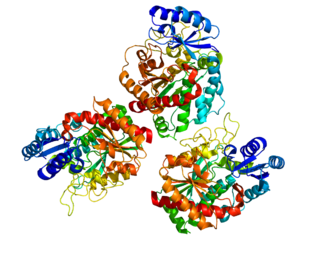
Carboxypeptidase B2 (CPB2), also known as carboxypeptidase U (CPU), plasma carboxypeptidase B (pCPB) or thrombin-activatable fibrinolysis inhibitor (TAFI), is an enzyme that, in humans, is encoded by the gene CPB2.
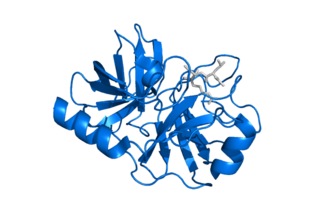
Kallikrein-5, formerly known as stratum corneum tryptic enzyme (SCTE), is a serine protease expressed in the epidermis. In humans it is encoded by the KLK5 gene. This gene is one of the fifteen kallikrein subfamily members located in a cluster on chromosome 19. Its expression is up-regulated by estrogens and progestins. Alternative splicing results in multiple transcript variants encoding the same protein.

Periplakin is a protein that in humans is encoded by the PPL gene.

Desmocollin-1 is a protein that in humans is encoded by the DSC1 gene.

Interleukin 13 receptor, alpha 1, also known as IL13RA1 and CD213A1, is a human gene.

Microfibrillar-associated protein 2 is a protein that in humans is encoded by the MFAP2 gene.
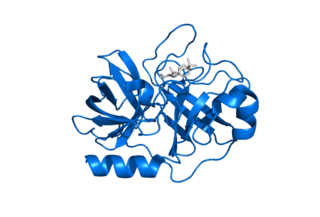
Kallikrein-related peptidase 7 (KLK7) is a serine protease that in humans is encoded by the KLK7 gene. KLK7 was initially purified from the epidermis and characterised as stratum corneum chymotryptic enzyme (SCCE). It was later identified as the seventh member of the human kallikrein family, which includes fifteen homologous serine proteases located on chromosome 19 (19q13).

DNA polymerase delta subunit 2 is an enzyme that in humans is encoded by the POLD2 gene. It is a component of the DNA polymerase delta complex.

Envoplakin is a protein that in humans is encoded by the EVPL gene.
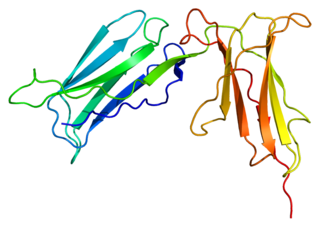
Killer cell immunoglobulin-like receptor 2DS4 is a protein that in humans is encoded by the KIR2DS4 gene.

T-cell surface glycoprotein CD1e, membrane-associated is a protein that in humans is encoded by the CD1E gene.

Semaphorin 7A, GPI membrane anchor (SEMA7A) also known as CD108, is a human gene.

Immunoglobulin superfamily, member 2 (IGSF2) also known as CD101, is a human gene.

Proton-coupled amino acid transporter 2 is a protein which in humans is encoded by the SLC36A2 gene.
PRINS is a long non-coding RNA. Its expression is induced by stress, and it may have a protective role in cells exposed to stress. It is over-expressed in the skin of patients with psoriasis. It regulates G1P3, a gene encoding a protein with anti-apoptotic effects in keratinocytes. Overexpression of PRINS may contribute to psoriasis via the down-regulation of G1P3.

Alpha-2-macroglobulin-like 1 abbreviated as α2ML1 is a protein that in humans is encoded by the A2ML1 gene. α2ML1 is a large, 180 kDa protein found in the epidermis. It is able to the inhibit the chymotryptic activity of KLK7.


